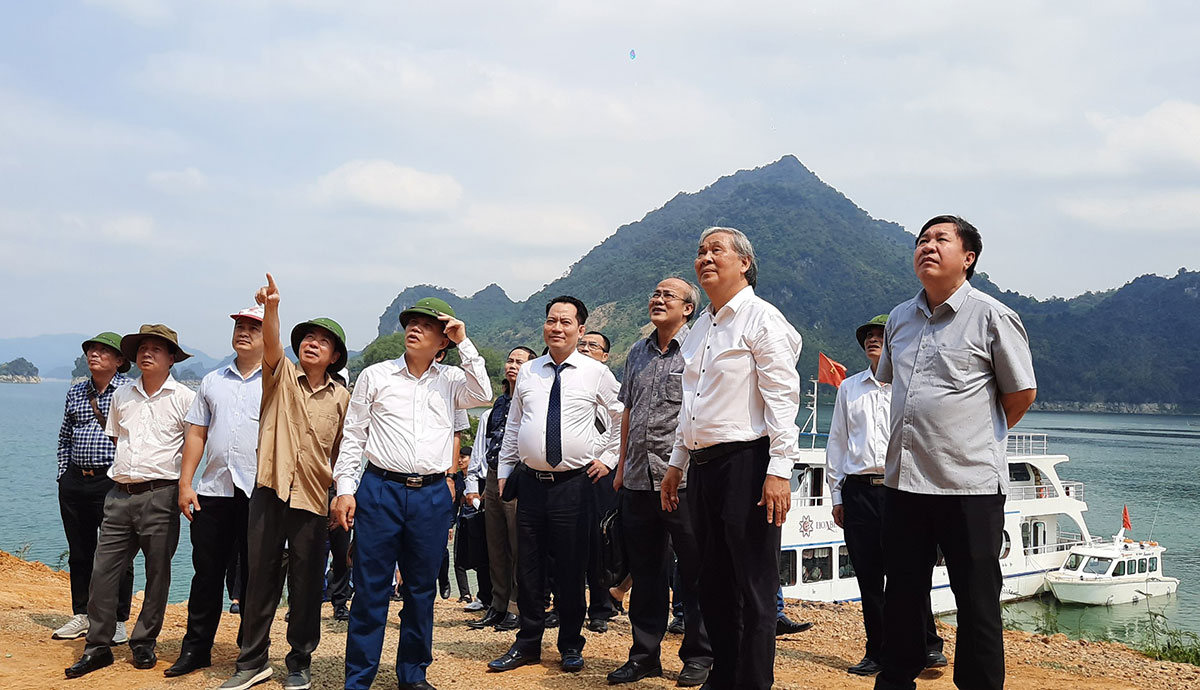
(HBO) – Coming to the countryside in Hoa Binh province, it is easy to see new vitality in each village and commune because the electricity - road - school - station system and key infrastructures are built spaciously and firmly. Paddy fields, mountains and forests stretch with creative and effective economic models.

Vice Secretary of the provincial Party Committee and Chairman of the provincial
People’s Committee Bui Van Khanh inspects projects in Hoa Binh lake.
The
new-style rural development campaign turned villages and communes into ideal
areas such as Ho 1 village. Over the past years, in order to mobilise the
involvement of the entire political system, the Chairman of the provincial
People’s Committee directed building an action plan for the effort and launched
an emulation drive called "Hoa Binh province joins hands to build new-style
rural areas”. In response to the 2020 campaign, the province mobilised about
85,000 workdays, allocated some 9,500 sq.m of land, raised over 20 billion VND
in cash and in kind worth more than 272 billion VND.
According
to the provincial People’s Committee, more than 16.2 trillion VND were raised
for the effort during the 2016-2020 period. The province issued a number of
mechanisms and policies to raise funds for communes to complete the building of
new-style rural areas.
As a
result, socio-economic infrastructure were upgraded in accordance with the
master plan, connecting with the provincial and regional socio-economic
infrastructure.
A
highlight was the effort of the district-level People’s Committees to step up
the restructuring of the agriculture sector to improve added value and fuel
sustainable development in combination with new rural development.
By the
end of 2020, the province had 12 communes meeting enhanced criteria for
new-style rural areas, 46 new-style model residential areas, 151 model gardens;
58 out of 131 communes achieving 19 criteria for new rural development. On
average, each commune met 15.31 criteria and there was not any commune meeting
below 10 criteria./.
The Standing Board of the Hoa Binh provincial Party Committee has agreed in principle on a proposal by the Standing Board of the Party Committee of Hoa Binh city to gather feedback on the city’s 1:2000 zoning plan, which forms part of its broader urban development strategy.
Hoa Binh province has made notable progress in public administration reform and digital government development, with the satisfaction index among citizens and businesses reaching over 84%, according to recent government evaluations.
Thanks to great efforts by local authorities in recent times, the governance and public administration performance of Mai Chau district has been significantly improved.
In the afternoon of June 6, the Party Committee, the People's Council, the People's Committee and the Fatherland Front of Lac Son district solemnly held a meeting to celebrate the 139th anniversary of the district's founding (1886–2025) and the 79th anniversary of the establishment of the district's Party Committee (1946–2025). There was the attendance of Mr. Bui Van Thang, the Vice Chairman of the Provincial People's Council; Mr. Quach Tat Liem, the Vice Chairman of the Provincial People's Committee; Ms. Dang Bich Ngoc, the Deputy Head of the National Assembly Delegation of the province; as well as the former leaders of the province and district through various periods, who are the natives of the district.
Implementing the Politburo’s Resolution No. 57-NQ/TW on breakthroughs in science – technology, innovation, and digital transformation is a golden opportunity for the northern mountainous province of Hoa Binh to renew growth model, improve competitive edge and shorten digital gap.
Resolution 57-NQ/TW, issued by the Politburo on December 22, 2024, identifies sci-tech, innovation, and digital transformation as strategic breakthroughs to build a developed and prosperous nation. In Hoa Binh province, this spirit is not just a slogan, it’s being put into action through concrete initiatives that form a "new development triangle”: digital citizenship, digital economy, and digital administration.



